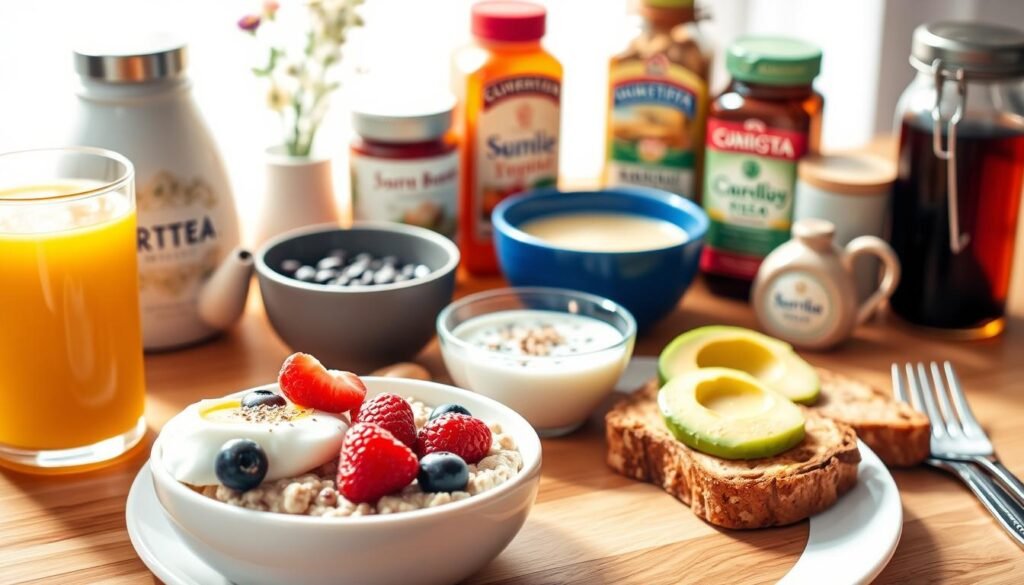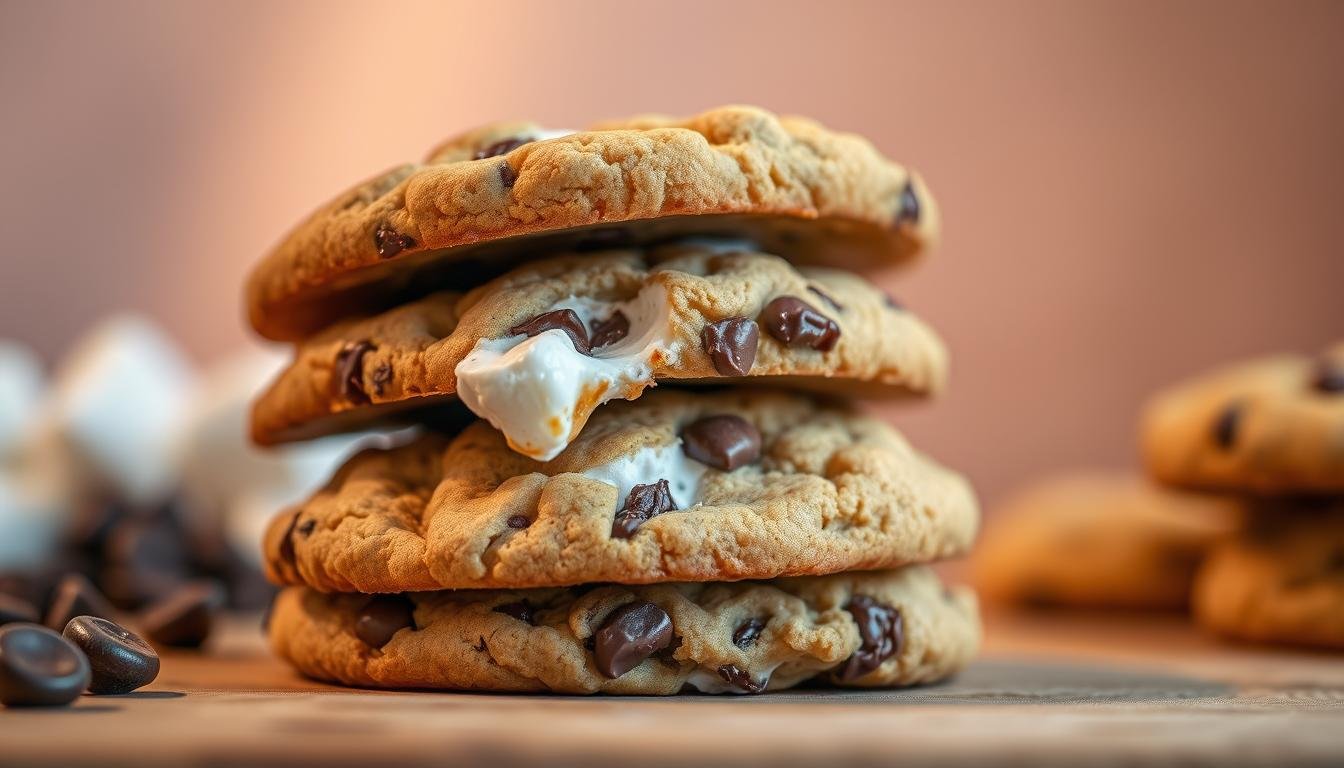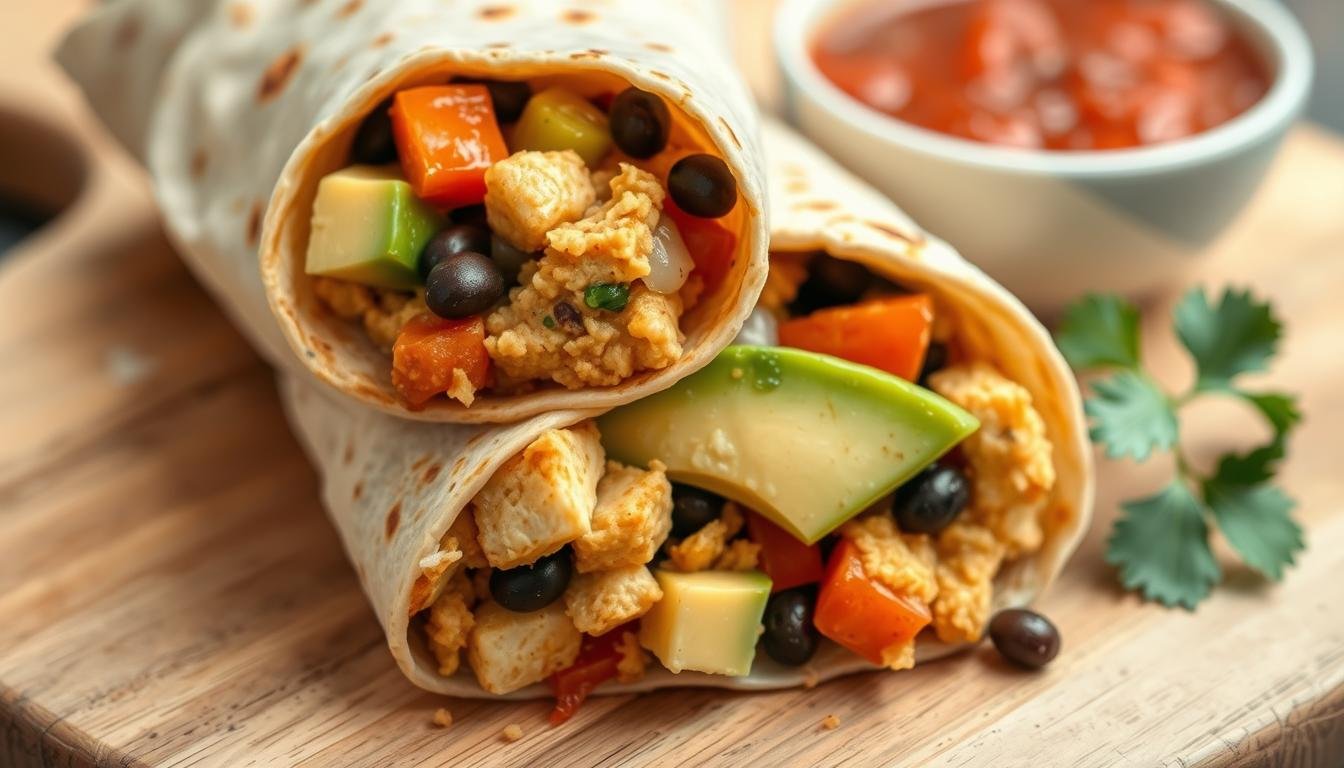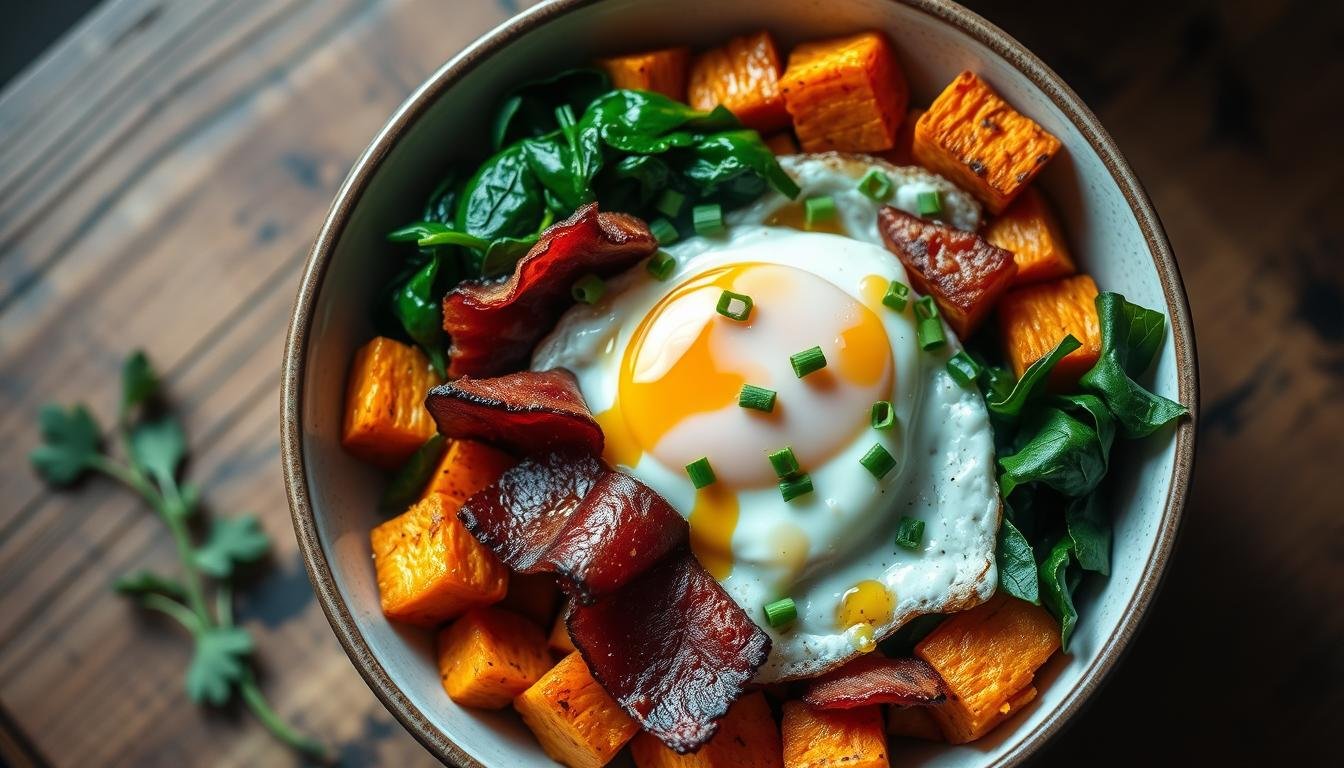Mornings with Crohn’s can feel like a minefield. You have to choose between being hungry and not wanting to trigger pain. What if your first meal could nourish you *and* your gut? For over 500,000 Americans with this condition, breakfast is more than just taste. It’s a key choice that affects energy, inflammation, and even if you stay in remission.
I’ve learned that the right breakfast can help your digestion. Studies say foods high in soluble fiber, like oatmeal, can lower inflammation in your gut. But, the wrong ingredient can make you tired or cause a flare-up. That’s why finding a balance between safety and nutrition is so important.
This guide has 10 simple recipes for sensitive stomachs. You’ll find anti-inflammatory foods, gentle cooking methods, and tips for when you’re in a flare-up. From protein-rich eggs to creamy chia puddings, these meals are easy on your stomach without losing flavor.
Key Takeaways
- Morning meals directly impact Crohn’s symptoms and remission maintenance
- Soluble fiber-rich foods like oatmeal reduce gut inflammation
- Eggs and lean proteins provide energy without irritation
- Meal prep strategies prevent stress-induced flare-ups
- Hydrating options like smoothies support nutrient absorption
Understanding Crohn’s Disease Dietary Needs
Managing Crohn’s starts with knowing what fuels your body without sparking inflammation. I’ve learned that breakfast is key for digestive comfort. But, it’s only when you balance avoiding triggers with nutrient-rich choices.
Foods to Avoid During Flares
When symptoms flare, these common offenders often worsen cramping and diarrhea:
- Raw vegetables: Uncooked broccoli or spinach can irritate inflamed intestines
- Dairy products: Lactose becomes harder to digest during active phases
- Whole grains: Bran’s insoluble fiber acts like sandpaper on sensitive guts
- Spicy seasonings: Capsaicin in chili peppers triggers pain receptors
A recent UMass Chan Medical School study confirms what many patients experience: “Soluble fiber from cooked oats or bananas reduces inflammation markers better than insoluble types during flares.”
Safe Ingredients for Sensitive Stomachs
These gentle options form the foundation of easy breakfast meals for Crohn’s disease:
- White rice: Provides calories without gut-scratching fiber
- Eggs: Soft-scrambled versions deliver protein without grease
- Peeled fruits: Cooked applesauce beats raw apple skins
- Silken tofu: Blends smoothly into anti-inflammatory shakes
Steaming transforms zucchini into a safe veggie option, while raw versions might cause distress. I always keep canned pumpkin handy – its soft texture and soluble fiber make it perfect for bad days.
10 Breakfast Ideas for Crohn’s Disease
Starting your day with Crohn’s-friendly meals is easy. You don’t have to give up taste or nutrients. I’ve made these breakfasts gentle on your stomach and packed with good stuff. You’ll find recipes for when you’re feeling bad, need to eat lightly, and when you’re feeling better.
Gentle Smoothies (3 Options)
Smoothies are great for sensitive stomachs. Just peel the fruits and blend well. Here are my favorites:
- Banana-Spinach Power: Blend 1 ripe banana, ½ cup peeled spinach, ¼ cup lactose-free yogurt, and almond milk. Add a teaspoon of honey for sweetness.
- Blueberry-Kale Refresh: Use peeled kale leaves (stems removed), ½ cup frozen blueberries, and coconut water. This matches the first source’s kale smoothie but skips dairy.
- Berry-Almond Cream: Mix ½ cup peeled strawberries, 1 tbsp almond butter, and oat milk. Inspired by the second source’s berry recipe, this version avoids seeds.
Low-Residue Breakfasts (3 Options)
These meals are low in fiber but high in comfort:
- Cream of Rice Porridge: Simmer ground rice in bone broth until creamy. Top with cinnamon or mashed banana.
- Egg & Zucchini Scramble: Sauté peeled, finely grated zucchini until soft. Combine with scrambled eggs and a pinch of salt.
- Oatmeal Custard: Cook rolled oats in lactose-free milk until mushy. Stir in a beaten egg for extra protein.
Remission-Friendly Meals (4 Options)
When you’re feeling better, try these meals:
- Low-Fiber Avocado Toast: Spread mashed avocado on toasted sourdough (choose white for lower fiber). Sprinkle with hemp seeds.
- Quinoa Breakfast Bowls: Top cooked quinoa with poached eggs and steamed carrots. Drizzle with olive oil.
- Lactose-Free Yogurt Parfait: Layer coconut yogurt, peeled peaches, and crushed rice cakes.
- Sweet Potato Hash: Roast peeled sweet potatoes and ground turkey. Season with turmeric for anti-inflammatory benefits.
Meal Prep Strategies for Crohn’s Management
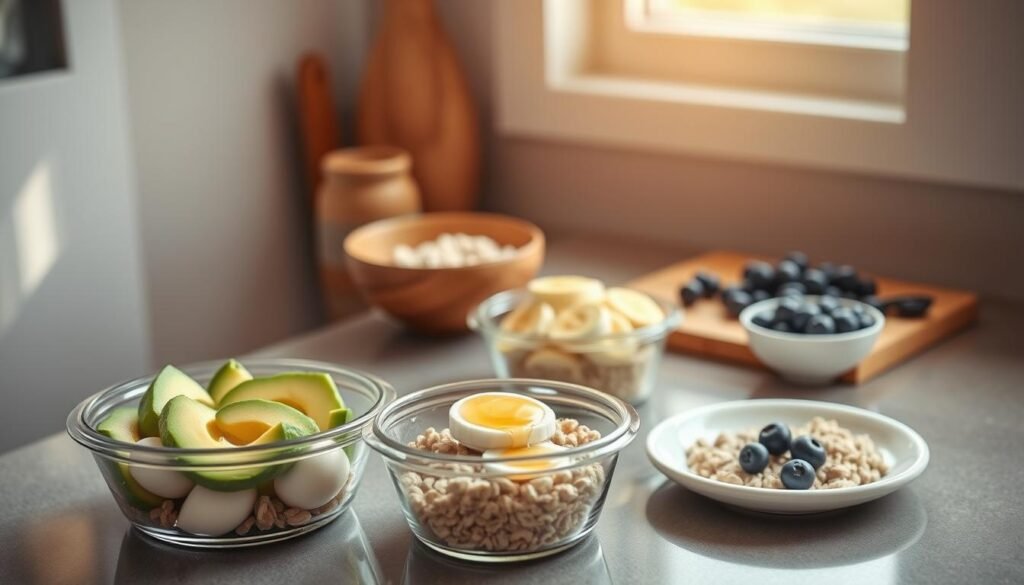
Planning meals ahead can make life easier. It ensures you have safe food ready when you need it. I focus on soft foods, rich nutrients, and good storage. This keeps my Crohn’s approved breakfast menu tasty and healthy.
Batch-Cooking Soft Grains
Grains like white rice and quinoa are easy on the stomach. I cook a little bit each day to keep things fresh:
| Day | Grain | Portion Size | Uses |
|---|---|---|---|
| 1 | White Rice | 4 cups | Porridge, savory bowls |
| 2 | Quinoa | 3 cups | Breakfast patties, warm cereal |
| 3 | Oatmeal | 5 cups | Overnight oats, baked dishes |
Keep grains in airtight containers. Reheat with a bit of water to keep them moist. This way, I can mix grains with soft toppings like apples or eggs.
Freezing Homemade Bone Broth
Bone broth is full of nutrients during flare-ups. Here’s how I freeze it:
- Strain cooled broth through cheesecloth to remove particles
- Pour into silicone ice cube trays (2 tbsp per cube)
- Freeze overnight, then transfer cubes to labeled bags
Three cubes make a serving. I add them to soups or drink the broth for hydration.
Safe Food Storage Practices
Follow USDA guidelines to keep food safe:
| Food Type | Container | Fridge Time | Freezer Time |
|---|---|---|---|
| Cooked Grains | Glass with lid | 3 days | 3 months |
| Blended Soups | BPA-free plastic | 2 days | 1 month |
| Poached Eggs | Shallow dish | 2 days | Not recommended |
Always label containers with dates. Keep raw meats on lower shelves to avoid contamination. I use blue lids for cold items and red for reheated foods.
Nutritional Balance for Crohn’s Patients
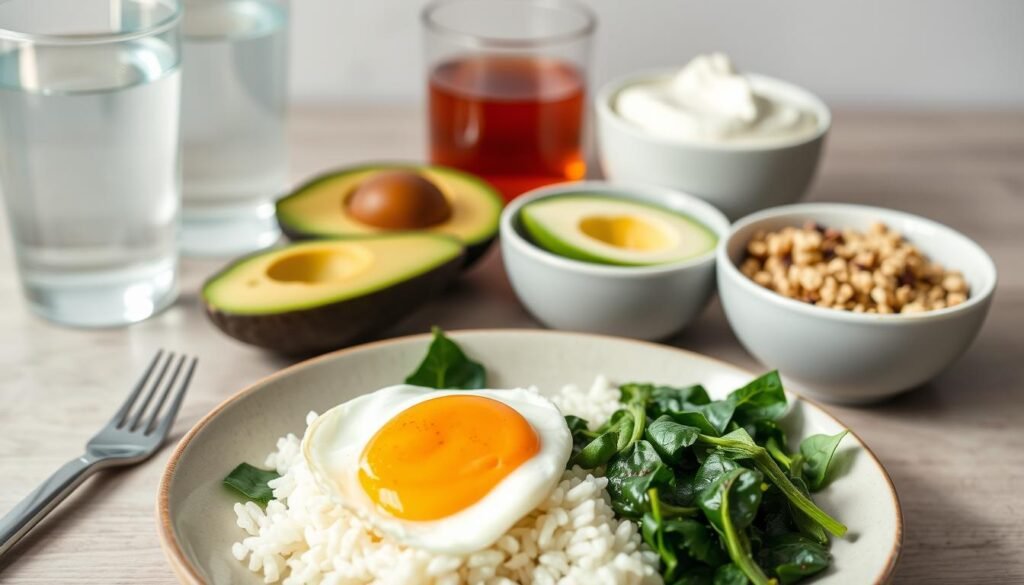
A good breakfast is key to fight Crohn’s. It helps heal, gives energy, and keeps your gut healthy. We’ll talk about protein, absorbing nutrients, and staying hydrated. These are important for managing Crohn’s.
Prioritizing Protein Intake
Protein helps fix your gut and keeps muscles strong, which is important during bad times. Try to get 20-30 grams of protein at breakfast. Choose foods that are easy to digest:
- Scrambled eggs with peeled tomatoes (vitamin C boosts iron absorption)
- Silken tofu blended into smoothies
- Low-fat Greek yogurt with peeled peaches
“Protein isn’t just about quantity—it’s about quality and timing,” says a study. Eat these foods with white toast to ease digestion.
Optimizing Nutrient Absorption
Crohn’s makes it hard to get nutrients. Smart food choices can help. Here are some tips:
- Combine iron-rich spinach (cooked) with bell peppers for vitamin C
- Use turmeric-infused olive oil in egg dishes to reduce inflammation
- Limit coffee/tea to 1 hour before/after meals to avoid iron blockage
Choose peeled and seeded fruits like applesauce. It’s full of potassium but has less fiber.
Hydration and Electrolyte Management
Dehydration is common with Crohn’s. Start with:
- Homemade oral rehydration solution (1L water + 6 tsp sugar + ½ tsp salt)
- Coconut water mixed with aloe vera juice
- Herbal teas like chamomile or ginger
Drink fluids slowly all morning. Foods like bananas add potassium without being hard to eat.
Managing Flares Through Breakfast Choices
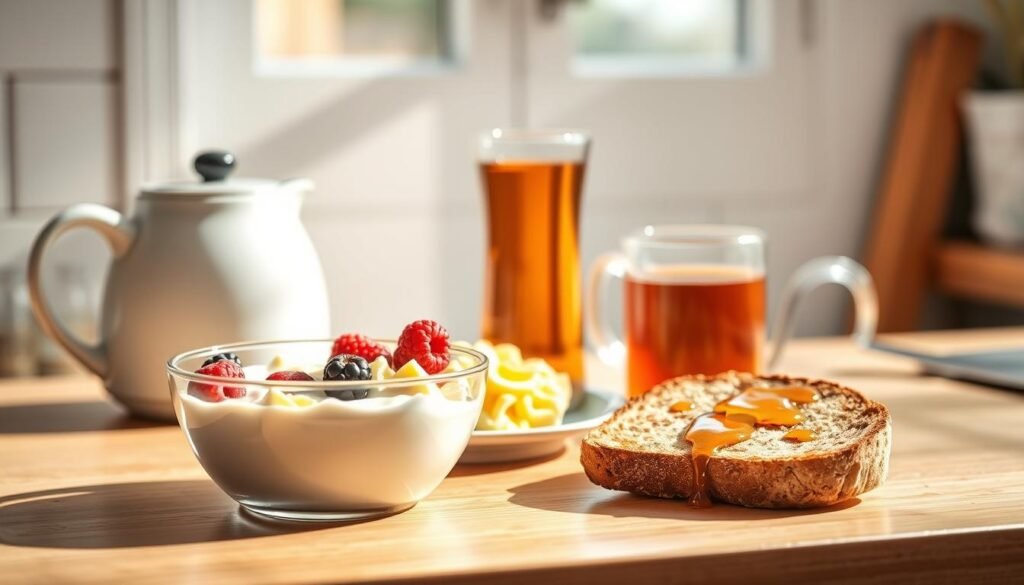
Breakfast is key when Crohn’s symptoms get worse. Paying attention to your body and changing meals fast can stop small issues from getting big. Let’s see how morning meals can help manage symptoms.
Spotting the Signals Your Body Sends
Crohn’s flares often give early signs. The Crohn’s & Colitis Foundation says increased abdominal tenderness or unexplained fatigue can mean a flare is coming. I watch for these signs:
- Changes in stool frequency or consistency
- Mild nausea lasting more than 24 hours
- Reduced appetite upon waking
“Patients should transition to low-residue options at the first sign of symptoms to reduce intestinal stress.”
CCFA Dietary Guidelines for Flares
Quick Food Swaps for Crisis Moments
When my gut feels upset, I switch to ultra-gentle breakfasts. I make these changes:
- Replacing oatmeal with cream of wheat
- Substituting fresh fruit with unsweetened applesauce
- Using almond milk instead of dairy in teas
These changes help me stay nourished while easing my digestive system. Sometimes, I choose bone broth-based soups over solid foods when I’m really sick.
Strategic Use of Meal Replacements
Nutritional supplements like Ensure Clear are key in three situations:
- When solid foods make me uncomfortable right away
- During hospital stays or travel issues
- When I lose more than 5% of my body weight
I keep these supplements on hand, but talk to my dietitian before using them a lot. They’re best for short-term use while I work on eating whole foods again.
IBD-Friendly Cooking Techniques
Learning new kitchen skills can make your breakfasts better for Crohn’s. Making small changes in how you cook can help. These changes keep your food safe and full of nutrients. Let’s look at three key ways to make easy breakfast meals for Crohn’s disease that help prevent flares and support remission.
Peeling and Seeding Produce
Peeling and seeding fruits and veggies makes them easier on your stomach. For example, when making baked apples, make sure to remove the skin. This is because apple skins have a lot of fiber that can make symptoms worse during flares.
Pro tip: Here’s how to safely prepare fruits:
- Wash produce under cool running water
- Use sharp peeler to remove all skin
- Slice vertically to remove seeds/core
This trick works for pears, peaches, and tomatoes too. Always throw away peels instead of composting them near where you’re cooking.
Low-Fat Cooking Methods
Using less fat can help avoid diarrhea and cramps. Here’s a comparison of different ways to cook eggs:
| Method | Fat Per Serving | Best For |
|---|---|---|
| Sautéing (non-stick spray) | 1g | Egg whites |
| Roasting (parchment-lined) | 3g | Vegetable frittatas |
| Steaming | 0g | Fish or vegetables |
Instead of frying eggs, try poaching them in water. This saves 5g of fat per egg. For more flavor without extra fat, roast veggies in bone broth.
Temperature Control Tips
Cooking food to the right temperature kills bad bacteria and makes it easier to digest. The USDA says to cook:
- Egg dishes: 160°F
- Ground meats: 165°F
- Reheated leftovers: 165°F
I use a digital thermometer to make sure food is cooked right. When you’re having a flare, cook eggs a bit longer so the yolks are solid. This makes them easier to digest.
Transitioning Between Diet Phases
Living with Crohn’s disease means changing your diet often. Your breakfast is very important when you’re feeling better or worse. We’ll look at how to make your morning meals gentle and full of nutrients.
Flare vs Remission Menus
When you’re in a flare, keep it simple. I eat foods like cream of rice or applesauce without peels. When you’re in remission, you can add foods that are good for you. Here’s what I eat:
| Flare Phase | Remission Phase |
|---|---|
| Mashed banana with almond butter (no chunks) | Quinoa porridge with chia seeds |
| Steamed egg whites | Scrambled eggs with spinach |
Reintroducing Foods Safely
After 7 days without symptoms, I try one new food every 72 hours. For nuts and seeds, my plan is:
- Days 1-3: 1 tsp smooth sunflower seed butter
- Days 4-6: 2 crushed pumpkin seeds in oatmeal
- Days 7-14: Watch how you react before eating more
Tracking Tolerance Levels
I use MyFitnessPal to track my meals and how I feel. If you like writing things down, a paper journal works too. Here’s what I always note:
- How much of each ingredient I eat
- How fast I digest food
- My energy 2 hours after eating
Conclusion
Starting with three main ideas, we can make breakfasts better for Crohn’s disease. Choose foods that are easy to digest, like ripe bananas or cooked oats, when you’re feeling bad. Add protein with eggs or smoothies to help your body heal.
Use ingredients that fight inflammation, like turmeric or ginger tea, to make your meals tasty and helpful.
Meal prep is a big help. Cooking quinoa in advance and storing it in glass containers makes quick meals easy. Freezing bone broth cubes adds nutrients to your morning soups. These steps help keep your diet consistent, even when your symptoms change.
The Crohn’s & Colitis Foundation says 68% of people feel better by changing what they eat. Keep track of how your body reacts with a food journal or apps like MyFitnessPal. Before making big changes, talk to a dietitian who knows about IBD through CCFA’s directory.
Breakfast is more than just food. It’s a way to take care of yourself and your digestive health. Start with one new recipe this week. This will help you feel more confident in managing Crohn’s through what you eat.

